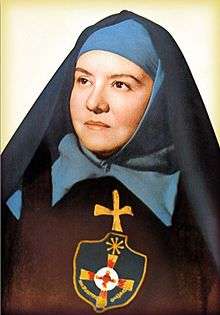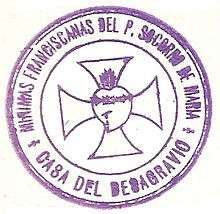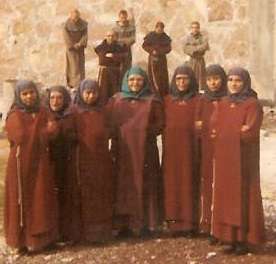María Concepción of the Nativity and the Perpetual Help of Mary

Perpetual Help of Mary, mfPS
(1st Foundation 1942)
Zamora, Michoacan, Mexico
María Concepción of the Nativity and the Perpetual Help of Mary (María Concepción de la Natividad y el Perpetuo Socorro de María) is the religious name of the Reverend Mother Foundress of The Order of Atonement of the Franciscan Minims of the Perpetual Help of Mary (mfPS) which she founded on June 24, 1942 in Zamora, Michoacan, Mexico.
Early life
Born María Concepción Zúñiga López, María Concepción states that when she was still a young girl, Jesus Christ instructed and dictated the Rule and Constitutions of the Order to her.[1]
During and after María Concepción's First Holy Communion (which her mother helped her daughter to make in secret because her father was a 33rd degree Mason and all the Catholic churches and schools in Mexico at that time were closed, and most priests, bishops and Religious had to go into in hiding[1] due to the violent slaughter of Catholics by government forces or "Federales" under the Calles government) the Real Presence of Jesus in the Eucharist spoke to little María Concepción and taught her the Faith and how to pray since she had received absolutely no religious education or catechesis at all during this time (1924-1928) of anti-Catholic, anti-Church religious persecution throughout Mexico by the atheist Mexican president Plutarco Elías Calles.
Living in a secular household during a time of violent religious persecution in Mexico, María Concepción Zúñiga López had never seen women living in a Religious community and did not even know Religious Life for women existed. At one point in her education, she was learning secretarial skills that include typing and short hand from a group of women who taught in a business school near her home. María Concepción told her spiritual director, a famous Mexican bishop in hiding, that she was drawn to a life of prayer and the bishop explained to her that the women who were teaching her were Carmelites in hiding (they did not wear a Religious habit but secular dresses) and actually belonged to a Religious Congregation (Catholic), the Carmelite Sisters of the Sacred Heart (Hermanas Carmelitas del Sagrado Corazon[2]) founded in María Concepción's home town of Jalisco by Venerable Mother María Luisa Josefa of the Most Blessed Sacrament.[3]
Her Apostolic Mission
| Mother María Concepción of the Nativity | |
|---|---|
|
Mother María Concepción with the Religious Nuns and Friars of the Order of Atonement, Christmas 1971 | |
| Religion | Roman Catholic |
| Order |
Order of Atonement of the Franciscan Minims of the Perpetual Help of Mary (1942–1979) |
| Personal | |
| Nationality |
Mexican Citizen (1914–1979) |
| Born |
María Concepción Zúñiga López 8 December 1914 Jalisco, Mexico |
| Died |
15 October 1979 (aged 64) Mexico City DF, Mexico |
| Senior posting | |
| Title |
"Nuestra Madre" Foundress of the Order of Atonement of the Franciscan Minims of the Perpetual Help of Mary |
| Period in office | 1942–1979 |
Franciscan Minims of the Perpetual Help of Mary (mfPS) live the Primitive Rule of Saint Francis of Assisi and at their Profession make five (5) Vows: Poverty, Chastity, Obedience, and two (2) special Vows particular to the Order, the Vow of Victim to the Divine Justice and Mercy of Christ, and the Vow of Obedience to the Pope. The Superior General of the Order of Atonement of the Franciscan Minims of the Perpetual Help of Mary is the Pope, so Christ instructed the young María Concepción Zúñiga López regarding the focus of the work of the Franciscan Minims for the Holy See, which included living and preaching the Gospel in word, work and prayer to end schism within the Church and to catechize and convert schismatics, apostates, and those who had, in any way, separated themselves from the Church and the Vicar of Christ. Without exception, Mother María Concepción of the Nativity and the Perpetual Help of Mary began all her writings and correspondence with the words: "Long Live the Vicar of Christ".[1] Pope Paul VI was the Vicar of Christ (1963-1978) during the Second Foundation of the Order of Atonement in Mexico City.[1]
Mother María Concepción of the Nativity and the Perpetual Help of Mary held that the work of the Apostolate of a Franciscan Minim Nuns begins with their motto "Charity and Immolation" through Perpetual Eucharistic adoration in union with the Eucharistic Victim Heart of Jesus in the Most Blessed Sacrament. Mother María Concepción of the Nativity and the Perpetual Help of Mary and the Minim Nuns associated with the Order of Atonement of the mfPS live a Religious Life that is both active and contemplative with a special focus on strengthening the family by catechizing Catholic mothers and women living in the world through frequent religious conferences and retreats for women given by the nuns.
The Order which began as a "Pious Union"[4] (the Code of Canon Law after 1983 uses the term Associations of the faithful [5][6]) in Zamora, Michoacán, Mexico on June 24, 1942 and given status as a Sodality on October 2, 1942 never ceased to exist canonically even though it was disbanded on October 23, 1951 by Bishop Jose G. Anaya. Canonical status was reaffirmed in Rome under Pope Paul VI on October 30, 1963 after Mother María Concepción made a trip to Rome under the auspices of this same Bishop of Zamora who had earlier disbanded the 1st Foundation. With the express authorization of the Sacred Congregation of Religious, dated October 1963, the Order was founded a second time in Chilapa, Guerrero, Mexico in January 1964. Again, it received approval as a Pious Union in Mexico on September 1, 1964 after being placed under the protection of a Mexican Bishop, Fidel de Sta Maria Cortes Perez, whom the Holy Father introduced to Mother María Concepción while she was in Rome. Pope Paul VI assigned this Bishop to assist the Foundress during her trip to Rome in October 1963, a trip she made to ask Pope Paul VI for His help to reestablish the Order and then to give the Order His full Papal Approval. Due to the untimely death of Pope Paul the VI and the deaths of several Bishops involved with promoting the Order, as well as, interference from certain Mexican prelates, including a Congregation of priests from Mexico and others working both in Mexico and inside the Vatican who opposed the Order's receiving direct Papal institution, approval and direction, the status of this request is still pending.[7]
Fidel Sta Maria Cortes Perez, Bishop of Chilapa, wrote on September 1, 1964 (the Feast of Saint Anna the Prophetess who was present when Mary and Joseph presented the Baby Jesus in the Temple 40 days after His Birth):
“Considering the good conduct, the noble goals that are proposed to atone to the Lord for the sins of men, of encouraging the spirit of prayer and of some other apostolates by the letter herewith,
WE APPROVE the Pious Union of the Franciscan Minims of the Perpetual Help of Mary, established in this city.”
Mother María Concepción of the Nativity and the Perpetual Help of Mary was not disturbed that she might die without seeing the final establishment and approval of the Order by the Holy See. In 1963, just prior to the end of her exclaustration María Concepción Zúñiga López wrote in a brief autobiography of her life about the founding of the Order of Atonement, which she handed to Pope Paul VI during her first meeting with this Vicar of Christ:
That is why, one of the mysteries, the most easily comprehensible — if the expression fits for the human mind — is to teach souls the value of suffering, of their voluntary crucifixion in union with Him, Christ immolated. That is, Victimhood to Divine Justice. And here again I emphasize and urge very fervently, pleading and asking for the approbation of the Order of Atonement, so that being spread all over the world, it may spread, on its part, that devotion that will save the world on the day of final judgment.
And if, so that this might be, it would be better that I were not on earth, so that the immense joy of seeing that ideal realized might not detract from the glory of God or the good of my soul, I believe that if Your Holiness were to ask God to take me, He would do so. For being then with Him, there would be no danger of vanity and everything would be for His greater glory.
— María Concepción Zúñiga López, My Best Book (October 3, 1963) translated from the Spanish by Sor San Andres[1]
Mother María Concepción of the Nativity and the Perpetual Help of Mary died on October 15, the Feast of Saint Teresa of Jesus aka Saint Teresa of Avila, in 1979.
Historic delays and setbacks both before and after María Concepción's death

FRANCISCAN MINIMS
OF THE PERPETUAL HELP
OF MARY
Seal designed and used by:
Rev Mother María Concepción
of the Nativity and the
Perpetual Help of Mary
In reviewing the lives of the saints and founders of religious communities within the church there are many examples of delay, betrayal, contradictions from members of the hierarchy and local prelates, persecutions, wars, schisms and setbacks of every sort.
While Mother María Concepción of the Nativity and the Perpetual Help of Mary was still alive but after the death of the bishop of Zamora foundation, the new bishop in the years following c. 1949–1952 along with some of the younger nuns wished to make changes to the order that were not consistent with, and actually contradicted, Christ's specific directives to the foundress. Rather than compromise the Work of Atonement, the foundress suffered the bishop's suppression of the order.[1] During the next 12 years of exclaustration Our Lord made it clear to María Concepción Zúñiga López that He had inspired others elsewhere worldwide regarding the formation of this Work of Atonement and Legion of Victim Souls. While Mexican prelates and others in Mexico failed to cooperate with Christ's grace, these graces were at the same time being extended to many others worldwide.[1] There appear to be striking similarities in the founding of Opus Dei during the Spanish Civil War by Saint Josemaría Escrivá (1928); in the establishment of the Missionaries of Charity by Blessed Mother Teresa of Calcutta (1946-1950), the founding of the Poor Clare Monastery of the Angels by Mother Angelica (1962) and Eternal Word Television Network (1981); in the establishment of the Order of Saint Benedict Daughters of Mary, Mother of Israel's Hope, Handmaids of the Family,[8] by Mother Miriam of Immaculate Heart Radio and Catholic Answers; and in the call of Pope John Paul II for religious orders to renew their communities which inspired the founding of the Franciscan Friars of the Renewal by Fr Benedict Groeschel, C.F.R. and seven (7) Order of Friars Minor Capuchin colleagues (1987); in the work of renewing Religious Life after Vatican II among the Dominican Sisters of St. Cecilia aka "the Nashville Dominicans", which led to new Religious foundations, including the Sisters of Life (1991) and the Dominican Sisters of Mary, Mother of the Eucharist (1996-1997) established by Cardinal John Joseph O'Connor; and many other extraordinary Works of Atonement worldwide including the Canons Regular of Jesus and the Sisters in Jesus the Lord with their missions in Vladivostok, Russia (1991 to present) and United States pro-life movement, which began in the USA between 1967 and 1970, and other manifestations of the Works of Atonement in Rwanda, Japan, Vietnam, the Philippines, China, Russia, Korea, Eastern Europe and in many other countries.
After the death of Mother María Concepción of the Nativity and the Perpetual Help of Mary, some in Mexico City who continued to live within the community in this Pious Union, along with others exterior to the community, gradually altered the Rule and Constitutions weakening the observance of the Primitive Rule of Saint Francis and such obligations as voting for a new Superior to direct the community on a regular basis. Eventually, spiritual direction and funding from those no longer in union with the Holy See provided the luxury of following a more comfortable devotional life along with the ability to develop properties in Mexico City and elsewhere. Notably, deletions and alterations in the writings of the Foundress and Founding documents began to be published.
— T Kandrew paraphrased from, Letters & Chron (1971-2015)
Such developments remain Secular institutes (some in union with the Holy See but others not in union, that is, in either material or formal schism). They offer their own singular vision and interpretation of the Work of Atonement and those living within or exterior to these institutions freely exercise their own interpretation of the Works of Atonement , to grow in perfection and the Charity of Christ.
Church approval can be delayed whenever interior locution or visions of Jesus and Mary are alleged. María Concepción was favored from the time of her First Holy Communion with these more unusual supernatural gifts. In 1932, at the age of 18, while still living a secular life in her family home in Jalisco and ten (10) years before the First Foundation of the Order in Zamora, María Concepción had a vision after which she illustrated and explained the Symbolic Image of the Divine Justice.[1]

The church gave its approval for the propagation of this Symbolic Image of the Divine Justice and the explanation of the vision with several imprimaturs including the most recent imprimatur of Fidel Sta Maria Cortes Perez, the Bishop of Chilapa, who was appointed by Pope Paul VI to protect the Second Foundation of the Order in Chilapa in 1964.
May ALL be For the Greater Glory of God. †AMDG†
— mfPS media closing, used in all correspondence and media published or edited by Rev Mother María Concepción of the Nativity and the Perpetual Help of Mary and the "Minims"[1]
References
- 1 2 3 4 5 6 7 8 9 María Concepción Zúñiga López. My Best Book. ESTRELLA Magazine, Mary Conzulo.
- ↑ "ocdmx". Retrieved 6 November 2016.
- ↑ "Mother Luisita". 14 July 2012. Retrieved 6 November 2016.
- ↑ "Dictionary : PIOUS UNION". Retrieved 6 November 2016.
- ↑ Under the 1917 Code of Canon Law, replaced in 1983 by a revised Code, associations of the faithful were called piae uniones ("pious unions"). Terms
- ↑ "Associationes fidelium quae ad exercitium alicuius operis pietatis aut caritatis erectae sun, nomine veniunt 'piarum unionum'; quae, si ad modum organici corporis sunt constitutae, 'sodalitia' audiunt" (Associations of the faithful which are established for carrying out some pious or charitable work are called "pious unions"; if they are constituted as an organic body, they are referred to as "sodalities") - canon 707 §1 of the 1917 Code of Canon Law
- ↑ María Concepción Zúñiga López. My Best book. María Concepción Zúñiga López aka Mary Conzulo.
- ↑ "Daughters of Mary, Mother of Israel's Hope". Retrieved 6 November 2016.
